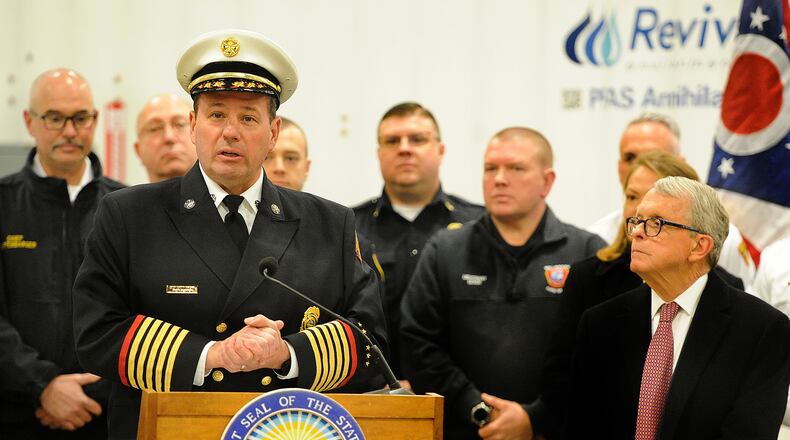“This foam was created to fight, smother flammable liquid fires,” said Ohio Gov. Mike DeWine at a press event at Wright State University’s Calamityville campus on Monday. “But after the flames go out, unfortunately the PFAS chemicals remain. They get into the soil, they run off into water and they threaten the health of firefighters who regularly risk their own lives for the safety of others.”
PFAS are a group of powerful, toxic chemicals created to be resistant to heat and other elements. PFAS are very difficult to break down due to their chemical composition, which consists of strong bonds of fluorine and carbon atoms. For this reason, they are often referred to as “forever chemicals.”
In 2022, the Ohio governor signed a law to ban the use of AFFF at firefighting training centers, a bill first introduced by state Rep. Phil Plummer, R-Butler Twp.
DeWine said that any fire department in the region can turn in containers of the foam to the Calamityville location to safely dispose of it, free of charge, during Ohio EPA collection events.
The Calamityville campus was formerly a cement factory that was remediated through the state’s environment agency, Ohio EPA director Anne Vogel said. There will be one collection event in every region of the state.
The state’s EPA director estimated that nearly 40,000 gallons of the toxic foam remain stockpiled throughout Ohio.
“We have been focused on PFAS,” she said. “Following the science, doing the testing of our public water systems, and now here we are able to actually collect this material from fire departments across the state.”
State Fire Marshal Deputy Chief Richard Sudler said that for years, AFFF had been the cornerstone of fire departments’ fight against flammable liquid fires. But the discovery of the health and environmental impact of forever chemicals has raised “significant concerns,” he said.
He applauded the program, saying it will create a “cleaner and safer future.”
“By eliminating the stockpile of AFFF, we are taking a critical step towards safeguarding our water sources and preserving the wellbeing of our communities,” Sudler said.
Through the program, AFFF is exposed to supercritical water oxidation, which effectively destroys AFFF and PFAS-contaminated wastewater to non-detectable levels. The technology used in the program was produced by science and technology company Batelle after nearly 20 years of research into PFAS.
Research shows PFAS have links to a few kinds of cancer, thyroid dysfunction, reproductive harm and other health concerns.
A Dayton Daily News investigation found that 15 of the region’s public water systems, which supply drinking water to hundreds of thousands of residents, have levels of PFAS that exceed a new legal limit of 4 parts per trillion (ppt) for the group of chemicals.
A major contributor to groundwater contamination from PFAS in this area is runoff from firefighting foam used over decades at Wright-Patterson Air Force Base and the Dayton International Airport because of its ability to extinguish jet fuel fires. This is one reason PFAS levels are particularly high under the base, water quality experts have said.
The takeback project is funded with settlement money that Ohio received as part of the state’s polychlorinated biphenyl (PCB) enforcement case against Monsanto, which was filed by then-Attorney General DeWine in 2018.
About the Author



